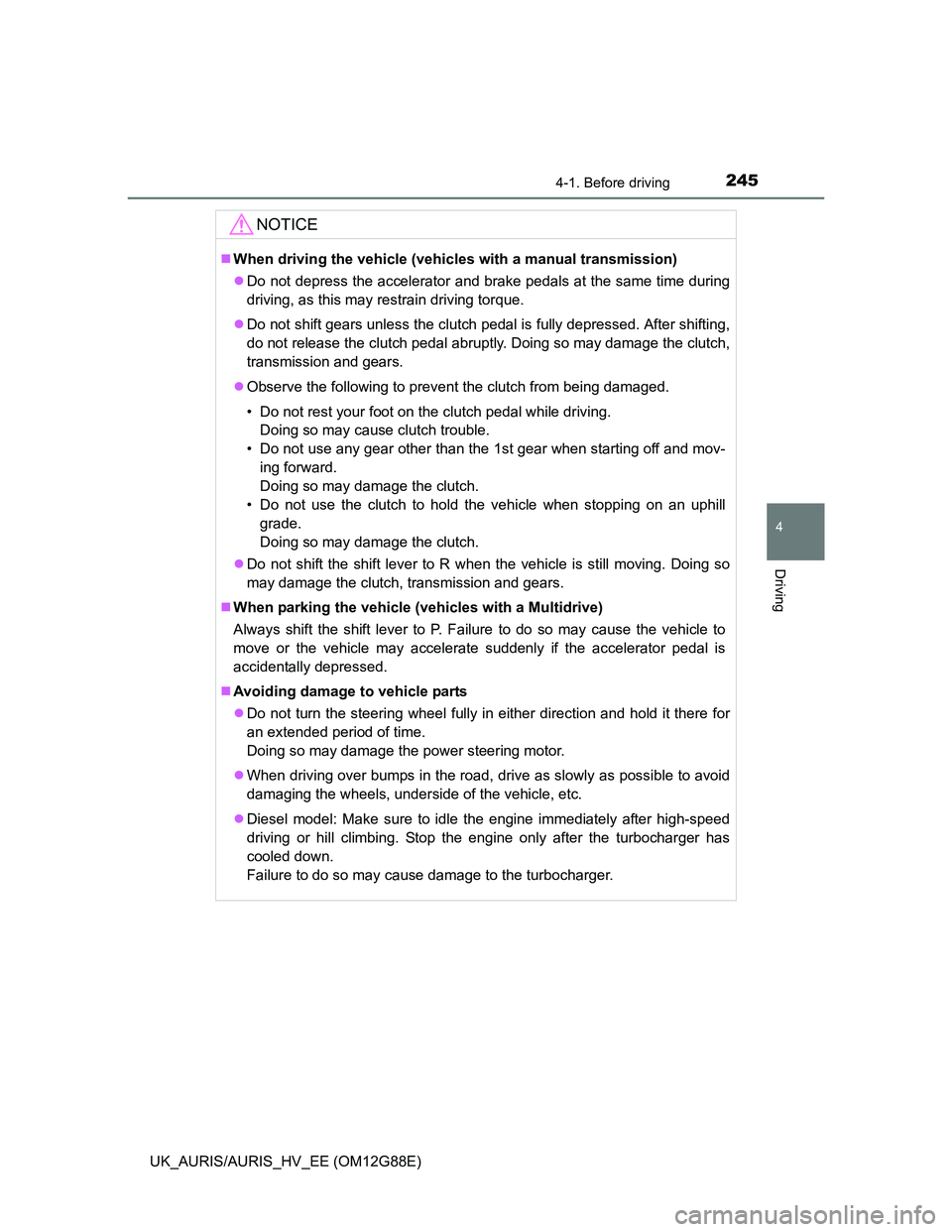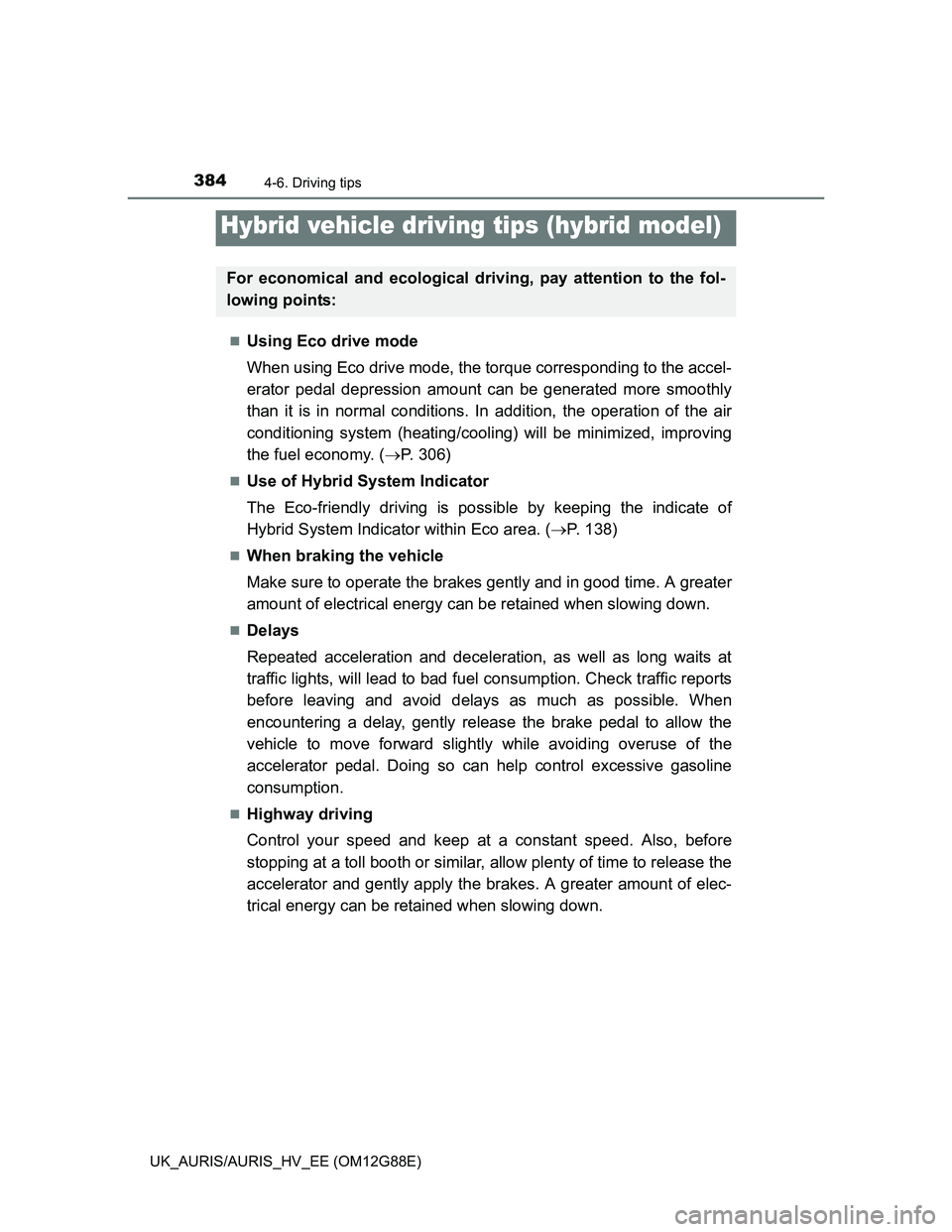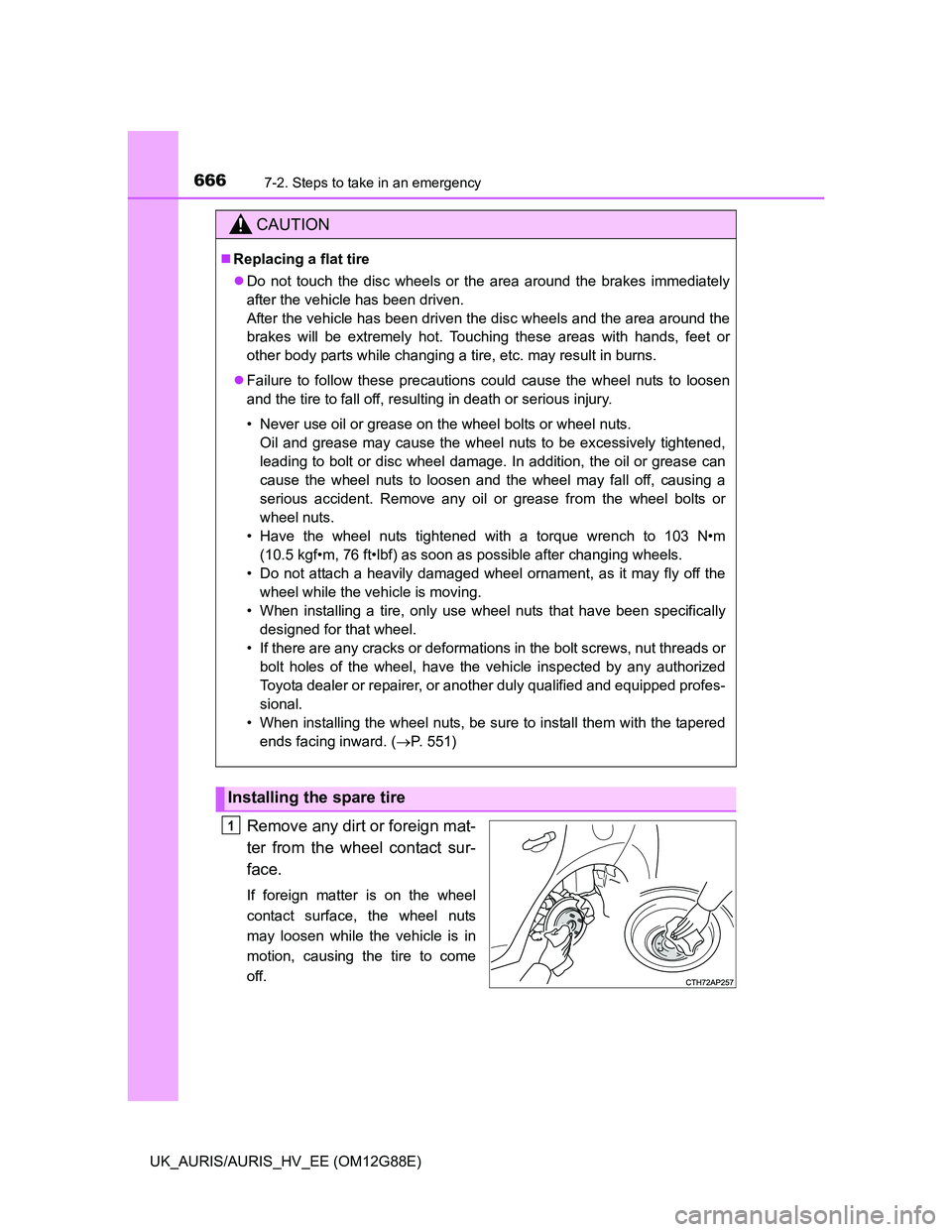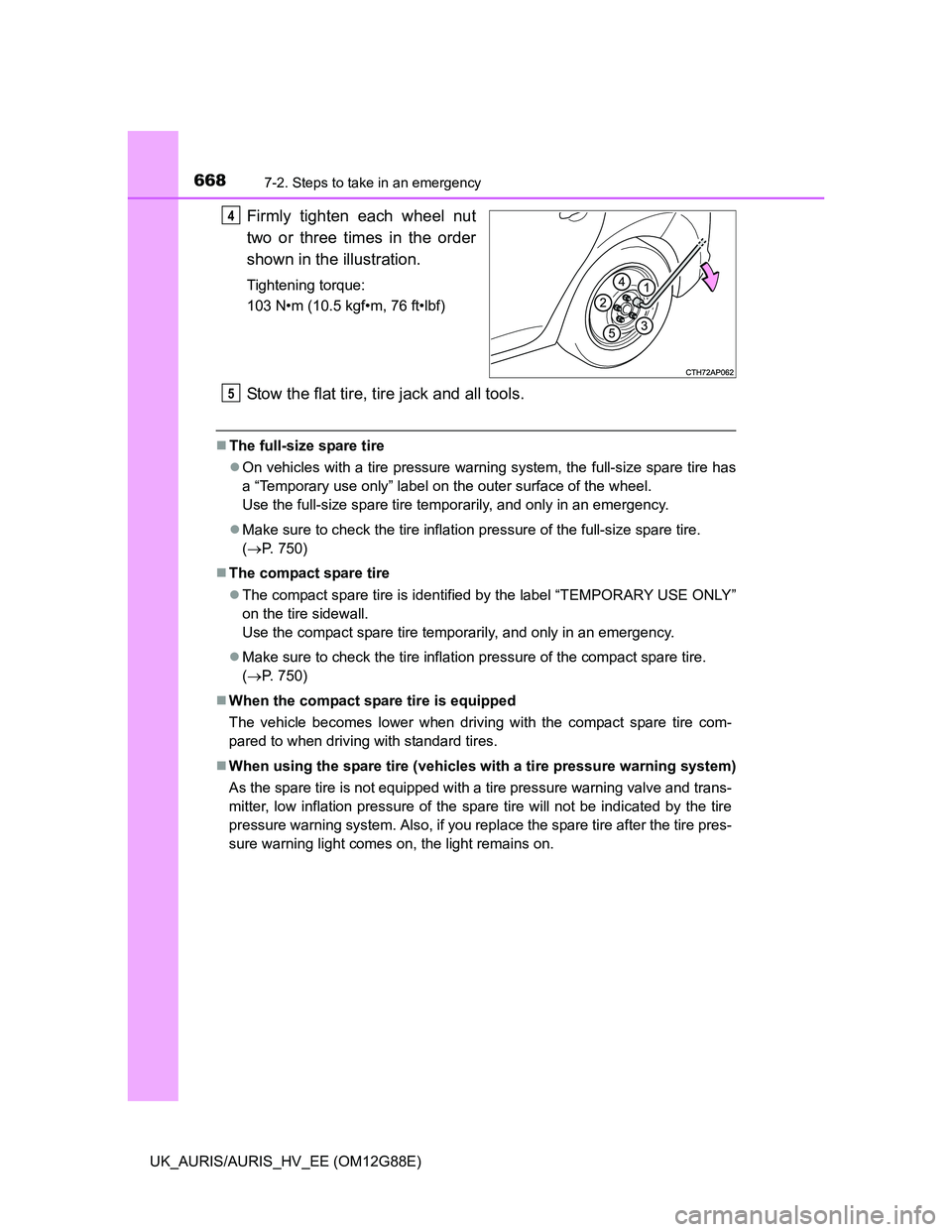Page 244 of 788

2444-1. Before driving
UK_AURIS/AURIS_HV_EE (OM12G88E)
CAUTION
Observe the following precautions.
Failure to do so may result in death or serious injury.
When braking
Except hybrid model: Do not pump the brake pedal if the engine stalls.
Each push on the brake pedal uses up the reserve for the power-assisted
brakes.
Except hybrid model: The brake system consists of 2 individual hydraulic
systems; if one of the systems fails, the other will still operate. In this case,
the brake pedal should be depressed more firmly than usual and the brak-
ing distance will increase.
Have your brakes fixed immediately.
Hybrid model: The brake system consists of 2 or more individual hydraulic
systems; if one of the systems fails, the other(s) will still operate. In this
case, the brake pedal should be depressed more firmly than usual and
the braking distance will increase. Have your brakes fixed immediately.
NOTICE
When driving the vehicle (vehicles without a manual transmission)
Do not depress the accelerator and brake pedals at the same time during
driving, as this may restrain driving torque.
Vehicles without a multi-mode manual transmission: Do not use the accel-
erator pedal or depress the accelerator and brake pedals at the same time
to hold the vehicle on a hill.
Vehicles with a multi-mode manual transmission: Do not use the acceler-
ator pedal or starting assist system to hold the vehicle on a hill.
Doing so may damage the clutch.
Page 245 of 788

2454-1. Before driving
UK_AURIS/AURIS_HV_EE (OM12G88E)
4
Driving
NOTICE
When driving the vehicle (vehicles with a manual transmission)
Do not depress the accelerator and brake pedals at the same time during
driving, as this may restrain driving torque.
Do not shift gears unless the clutch pedal is fully depressed. After shifting,
do not release the clutch pedal abruptly. Doing so may damage the clutch,
transmission and gears.
Observe the following to prevent the clutch from being damaged.
• Do not rest your foot on the clutch pedal while driving.
Doing so may cause clutch trouble.
• Do not use any gear other than the 1st gear when starting off and mov-
ing forward.
Doing so may damage the clutch.
• Do not use the clutch to hold the vehicle when stopping on an uphill
grade.
Doing so may damage the clutch.
Do not shift the shift lever to R when the vehicle is still moving. Doing so
may damage the clutch, transmission and gears.
When parking the vehicle (vehicles with a Multidrive)
Always shift the shift lever to P. Failure to do so may cause the vehicle to
move or the vehicle may accelerate suddenly if the accelerator pedal is
accidentally depressed.
Avoiding damage to vehicle parts
Do not turn the steering wheel fully in either direction and hold it there for
an extended period of time.
Doing so may damage the power steering motor.
When driving over bumps in the road, drive as slowly as possible to avoid
damaging the wheels, underside of the vehicle, etc.
Diesel model: Make sure to idle the engine immediately after high-speed
driving or hill climbing. Stop the engine only after the turbocharger has
cooled down.
Failure to do so may cause damage to the turbocharger.
Page 384 of 788

384
UK_AURIS/AURIS_HV_EE (OM12G88E)
4-6. Driving tips
Using Eco drive mode
When using Eco drive mode, the torque corresponding to the accel-
erator pedal depression amount can be generated more smoothly
than it is in normal conditions. In addition, the operation of the air
conditioning system (heating/cooling) will be minimized, improving
the fuel economy. (P. 306)
Use of Hybrid System Indicator
The Eco-friendly driving is possible by keeping the indicate of
Hybrid System Indicator within Eco area. (P. 138)
When braking the vehicle
Make sure to operate the brakes gently and in good time. A greater
amount of electrical energy can be retained when slowing down.
Delays
Repeated acceleration and deceleration, as well as long waits at
traffic lights, will lead to bad fuel consumption. Check traffic reports
before leaving and avoid delays as much as possible. When
encountering a delay, gently release the brake pedal to allow the
vehicle to move forward slightly while avoiding overuse of the
accelerator pedal. Doing so can help control excessive gasoline
consumption.
Highway driving
Control your speed and keep at a constant speed. Also, before
stopping at a toll booth or similar, allow plenty of time to release the
accelerator and gently apply the brakes. A greater amount of elec-
trical energy can be retained when slowing down.
Hybrid vehicle driving tips (hybrid model)
For economical and ecological driving, pay attention to the fol-
lowing points:
Page 666 of 788

6667-2. Steps to take in an emergency
UK_AURIS/AURIS_HV_EE (OM12G88E)
Remove any dirt or foreign mat-
ter from the wheel contact sur-
face.
If foreign matter is on the wheel
contact surface, the wheel nuts
may loosen while the vehicle is in
motion, causing the tire to come
off.
CAUTION
Replacing a flat tire
Do not touch the disc wheels or the area around the brakes immediately
after the vehicle has been driven.
After the vehicle has been driven the disc wheels and the area around the
brakes will be extremely hot. Touching these areas with hands, feet or
other body parts while changing a tire, etc. may result in burns.
Failure to follow these precautions could cause the wheel nuts to loosen
and the tire to fall off, resulting in death or serious injury.
• Never use oil or grease on the wheel bolts or wheel nuts.
Oil and grease may cause the wheel nuts to be excessively tightened,
leading to bolt or disc wheel damage. In addition, the oil or grease can
cause the wheel nuts to loosen and the wheel may fall off, causing a
serious accident. Remove any oil or grease from the wheel bolts or
wheel nuts.
• Have the wheel nuts tightened with a torque wrench to 103 N•m
(10.5 kgf•m, 76 ft•lbf) as soon as possible after changing wheels.
• Do not attach a heavily damaged wheel ornament, as it may fly off the
wheel while the vehicle is moving.
• When installing a tire, only use wheel nuts that have been specifically
designed for that wheel.
• If there are any cracks or deformations in the bolt screws, nut threads or
bolt holes of the wheel, have the vehicle inspected by any authorized
Toyota dealer or repairer, or another duly qualified and equipped profes-
sional.
• When installing the wheel nuts, be sure to install them with the tapered
ends facing inward. (P. 551)
Installing the spare tire
1
Page 668 of 788

6687-2. Steps to take in an emergency
UK_AURIS/AURIS_HV_EE (OM12G88E)
Firmly tighten each wheel nut
two or three times in the order
shown in the illustration.
Tightening torque:
103 N•m (10.5 kgf•m, 76 ft•lbf)
Stow the flat tire, tire jack and all tools.
The full-size spare tire
On vehicles with a tire pressure warning system, the full-size spare tire has
a “Temporary use only” label on the outer surface of the wheel.
Use the full-size spare tire temporarily, and only in an emergency.
Make sure to check the tire inflation pressure of the full-size spare tire.
(P. 750)
The compact spare tire
The compact spare tire is identified by the label “TEMPORARY USE ONLY”
on the tire sidewall.
Use the compact spare tire temporarily, and only in an emergency.
Make sure to check the tire inflation pressure of the compact spare tire.
(P. 750)
When the compact spare tire is equipped
The vehicle becomes lower when driving with the compact spare tire com-
pared to when driving with standard tires.
When using the spare tire (vehicles with a tire pressure warning system)
As the spare tire is not equipped with a tire pressure warning valve and trans-
mitter, low inflation pressure of the spare tire will not be indicated by the tire
pressure warning system. Also, if you replace the spare tire after the tire pres-
sure warning light comes on, the light remains on.
4
5
Page 740 of 788
7408-1. Specifications
UK_AURIS/AURIS_HV_EE (OM12G88E)
Electric motor (traction motor) (hybrid model)
Ty p ePermanent magnet motor
Maximum output60 kW
Maximum torque207 N•m (21.1 kgf•m, 153 ft•lbf)
Hybrid battery (traction battery) (hybrid model)
Ty p eNickel-Metal hydride battery
Voltage7.2 V/module
Capacity6.5 Ah (3HR)
Quantity28 modules
Overall voltage201.6 V
Page 750 of 788
7508-1. Specifications
UK_AURIS/AURIS_HV_EE (OM12G88E)
Ty p e A
*1: “For optimizing fuel economy, ECO tire pressure is recommended. Tire
pressure affects traveling comfort, road noise and steering characteristics.”
*2: Hybrid model (with ECO tire pressure label)
*3: 1ND-TV engine (with ECO tire pressure label)
Tires and wheels
Tire size195/65R15 91H
Tire inflation pres-
sure
(Recommended
cold tire inflation
pressure)
Vehicle speed
Front wheel
kPa (kgf/cm2
or bar, psi)
Rear wheel
kPa (kgf/cm2
or bar, psi)
More than 160
km/h (100 mph)260 (2.6, 38)260 (2.6, 38)
Normal pressure:
160 km/h (100
mph) or less
230 (2.3, 33)230 (2.3, 33)
ECO pressure*1:
160 km/h (100
mph) or less250 (2.5, 36)*2
260 (2.6, 38)*2
270 (2.7, 39)*3
250 (2.5, 36)*2
250 (2.5, 36)*2
260 (2.6, 38)*3
Wheel size15 6 J
Wheel nut torque103 N•m (10.5 kgf•m, 76 ft•lbf)
Page 751 of 788
7518-1. Specifications
UK_AURIS/AURIS_HV_EE (OM12G88E)
8
Vehicle specifications
Ty p e B
*1: “For optimizing fuel economy, ECO tire pressure is recommended. Tire
pressure affects traveling comfort, road noise and steering characteristics.”
*2: 1AD-FTV engine
*3: Hybrid model (with ECO tire pressure label)
Tire size205/55R16 91V
Tire inflation pres-
sure
(Recommended
cold tire inflation
pressure)
Vehicle speed
Front wheel
kPa (kgf/cm2
or bar, psi)
Rear wheel
kPa (kgf/cm2
or bar, psi)
More than 160
km/h (100 mph)270 (2.7, 39)*2
260 (2.6, 38)260 (2.6, 38)
Normal pressure:
160 km/h (100
mph) or less240 (2.4, 35)*2
230 (2.3, 33)230 (2.3, 33)
ECO pressure*1:
160 km/h (100
mph) or less
250 (2.5, 36)*3250 (2.5, 36)*3
Wheel size16 6 1/2 J
Wheel nut torque103 N•m (10.5 kgf•m, 76 ft•lbf)